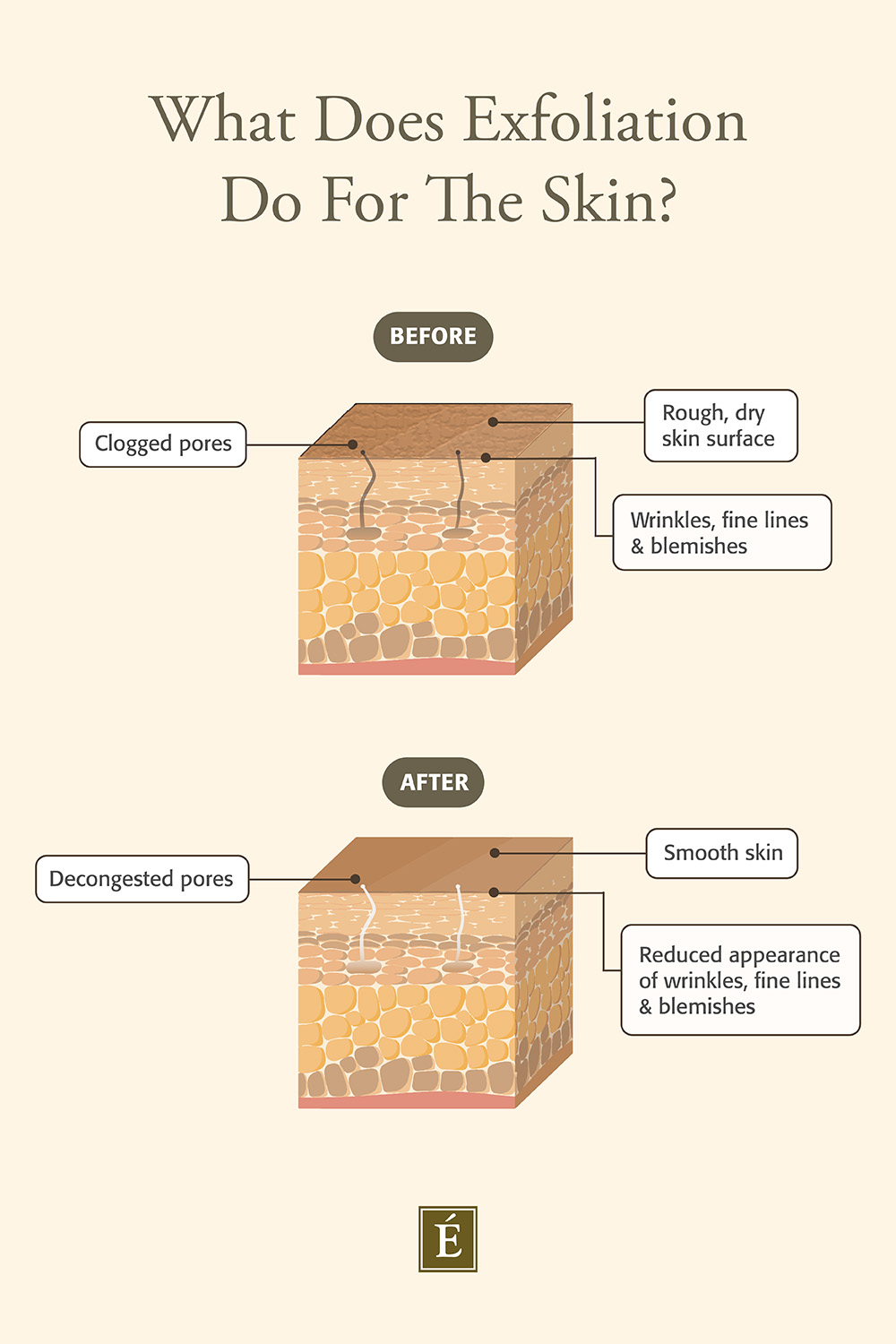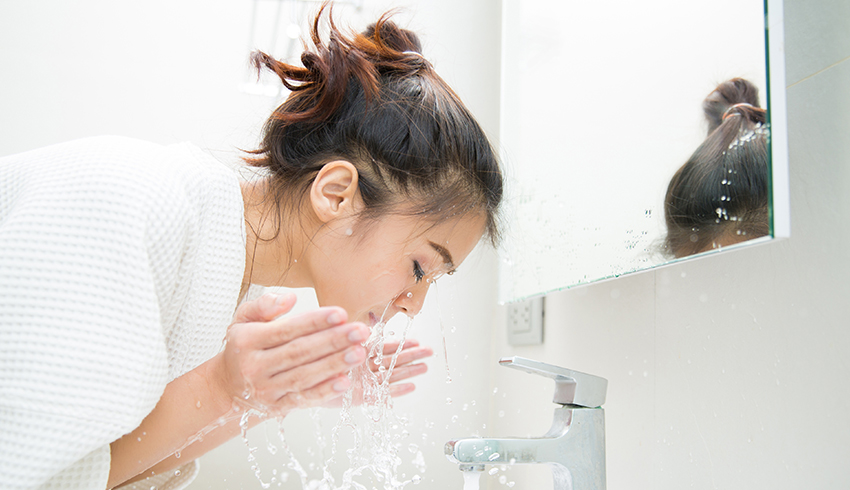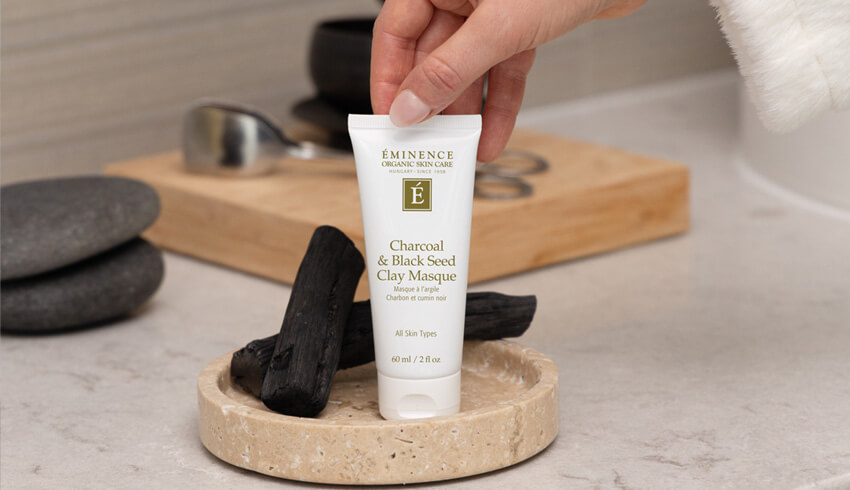
We all know that exfoliation is an essential part of achieving healthy, glowing skin, especially in your late twenties, thirties and beyond! This is when your skin’s renewal process begins to slow down naturally. The important thing to remember is that, regardless of what type of exfoliation you choose, there are several key steps you need to follow to ensure you get the most out of your skin care treatments. Before you go skin deep, read on to find out more about what exfoliation is, how it benefits the skin and the dos and don'ts of exfoliating treatments.
Key Takeaways:
- Exfoliation removes dead skin cells to reveal glowing, youthful skin while boosting skin renewal and improving tone and texture.
- Regular exfoliation unclogs pores and helps skin care products absorb.
- Choose the right exfoliant for your skin type — chemical for oily or mature skin, physical for all types needing gentle renewal.
- Always follow exfoliation with SPF protection to prevent sun damage and maintain a bright, youthful complexion.
- Avoid over-exfoliating or using synthetic scrubs; opt for natural, organic exfoliators for safer, eco-friendly skin care results.
What Does an Exfoliator Do?
The purpose of an exfoliator is to remove the dull surface layers of dead skin cells to reveal the new, younger, brighter-looking skin beneath. As well as helping to unclog pores and smooth the appearance of the skin, an exfoliator can improve skin tone, minimize the look of fine lines and wrinkles and help other skin care products to penetrate deeper.

Benefits of Exfoliating
By removing the superficial layer of dead cells that accumulate on the skin’s surface, exfoliating can give the complexion a radiant glow and clear the way for your skin care, letting it do its job without needing to fight through a layer of dull, dead skin. Let’s explore the benefits:
Improves Skin Tone & Texture: When the dead skin is washed away, fresh, “new” skin is revealed, creating a smoother feel and a more even complexion.
Unclogs Pores: Dead skin cells and debris that can get stuck in pores and lead to blackheads and whiteheads. Exfoliation uses physical or chemical means to dissolve that debris.
Increases Product Penetration: When those dead skin cells are gone, that clears the way for moisturizers, serums and other treatments to absorb more easily into the skin, making them more effective.
Promotes Cell Turnover: Out with the old, in with the new! Exfoliation helps stimulate new cell growth, making cell turnover faster and more efficient. The dead skin will linger if it’s not exfoliated away.
You can choose to use a physical exfoliant (typically a scrub, textured brush or cloth) or a chemical exfoliant (an acid-based peel).
What does exfoliating scrub do? Physical exfoliants (like scrubs) contain fine granules and are gritty in texture. When massaged into the skin, they physically buff off dead skin cells. Physical scrubs can be made from ingredients like exfoliating flours (rice, chickpea, adzuki and oat, for example) that buff and smooth the skin, leading to shedding of the dead layer.
What does a chemical exfoliant do? Chemical exfoliants can use acids like AHAs (alpha hydroxy acids) or BHAs (beta hydroxy acids) to clear the dead skin from the surface. Typically, a chemical exfoliant with a BHA, like salicylic acid, is ideal for acne-prone and oily skin types, as it works by penetrating the pores, allowing it to target blackheads and whiteheads. In contrast, AHAs, like glycolic acid or lactic acid, are great for dry or mature skin as AHAs work on the skin’s surface and focus on the visible signs of aging.
While the exfoliation process is one of the keys to creating and maintaining healthy skin, it’s not as simple as it sounds. It can be overdone and cause more harm than good if performed improperly. To help you with your mission for a brighter, healthier complexion, we’ve gathered some exfoliation dos and don'ts, so you can do it the right way!
Exfoliation Dos & Don'ts
Do: Determine Your Skin Type
To get the most out of exfoliation and to avoid any unpleasant side effects, familiarize yourself with your skin type. Remember that a skin type is different from a skin concern. Skin types are classified into just five categories, whereas skin concerns are the multitude of conditions that you want to treat, and can include blemishes, wrinkles and sun damage.
The five skin types are:
So, let’s illustrate a scenario: Your skin is prone to irritation and redness, and you have a few dark spots on your face due to sun damage. The skin care analysis? Your skin type is most likely “sensitive” and the skin concern that you want to target are the dark spots or uneven skin tone.
The truth is, determining your skin type can be a little tricky. Skin Inc Magazine recommends undergoing a thorough skin analysis by a professional esthetician prior to receiving any type of exfoliation treatment. To find an authorized Eminence Organics esthetician in your area, see the Spa Locator on our website.
Don’t: Exfoliate Irritated Skin
Is your skin feeling irritated and sore? Whether it’s a sunburn, sensitivity or a skin reaction caused by another product, any type of irritation or redness is a good reason to avoid exfoliation. In this case, sloughing away at your skin could cause more harm than good.
Our Eminence Organics Product Support Representatives share that over-exfoliating the skin may compromise the outermost layer known as the skin’s natural moisture barrier. This layer barrier helps our skin retain moisture and provides protection from environmental threats. A compromised barrier can show up as red, irritated, inflamed skin, or as an overproduction of oil, which can lead to potential breakouts. We recommend holding off on any type of treatment until your skin has completely recovered.
Do: Follow Exfoliation With SPF
After exfoliation, your skin is more susceptible to damage from the sun or other environmental elements. When it comes to your daily skin care routine, sun protection is a must. Once you’ve buffed away the dull layers of your skin, your complexion immediately becomes more sensitive, so it's crucial to apply an SPF.
Don’t: Use Synthetic Exfoliants
Not only can synthetic exfoliants like plastic microbeads harm your skin, they can also cause intense damage to our environment. In 2015, the California State Assembly passed a bill restricting the sale of personal care products that contain plastic microbeads. You can opt for skin care products that use natural and organic alternatives to plastic microbeads. The Monoi Age Corrective Exfoliating Cleanser provides rejuvenating benefits and is more hydrating for those in drier climates this time of year. It’s also cruelty-free and formulated without parabens, sodium lauryl sulfates, synthetic dyes, petrochemicals, animal by-products, phthalates, GMOs and triclosan.
Do: Use Caution When Combining Exfoliation Treatments
Although some exfoliation treatments work well together, there are some skin care combinations that should be avoided. When using retinol treatments, for example, it’s recommended that you avoid applying our VitaSkin™ Exfoliating Peels and use caution when undergoing additional exfoliation procedures such as waxing eyebrows, chemical peels, microdermabrasion and laser treatments. This also applies to over-the-counter medications. To be safe, it’s always best to consult your physician before undergoing any intensive exfoliation treatments. We recommend the Bamboo Firming Fluid as an alternative to conventional retinol. This concentrate contains a Natural Retinol Alternative, which is safe to combine with other exfoliating products.
Some exfoliation treatments can be combined safely, and we recommend pairing our VitaSkin™ Exfoliating Peels with products like our Strawberry Rhubarb Dermafoliant and our Yam & Pumpkin Enzyme Peel 5%. These exfoliants can actually boost results when used prior to the exfoliating peels. If you'd like to learn more about the benefits of exfoliating or how to exfoliate properly, our Lead Skin Care Trainer Natalie Pergar answers all your exfoliating questions in this In The Mix video.
Best Exfoliating Products for Your Skin Type
Sensitive Skin
As mentioned above, if your skin reactive and easily irritated, you may have sensitive skin, which means you need to be very selective with what products you apply, particularly when it comes to exfoliation. Try the Barbados Cherry Enzyme Cleansing Powder, our 2-in-1 exfoliating cleanser. Ideal for all skin types, this unique cleanser begins as a powder and turns into a soft, creamy foam when mixed with water. Gently massage into the skin to experience the mild exfoliation provided by actinidin and papain enzymes, while Barbados cherry, Kakadu plum and diatomaceous earth work together to leave your skin even and balanced-looking.
Normal Skin
You know you have normal skin if your complexion always looks smooth and even (lucky you!), and if it is not overly dry, oily or sensitive. To maintain healthy, normal skin, we recommend using the Strawberry Rhubarb Dermafoliant. This gentle scrub removes impurities and brightens your complexion with the help of salicylic acid from strawberries. In addition to exfoliation, rhubarb also provides vitamins and ascorbic acid to improve the look of fine lines and wrinkles.
Dry Skin
You may have dry skin if your skin feels tight and lacks moisture. Your pores will appear almost nonexistent. You may also notice flakiness and a rough skin texture. Dry skin will benefit from using our Firm Skin Acai Exfoliating Peel as it is packed with antioxidants and includes glycolic and lactic acid to gently exfoliate dry skin. Over time, exfoliation should reveal softer, smoother skin beneath, resulting in a texture that no longer appears flaky.
 Oily Skin
Oily Skin
Oily skin is characterized by a shiny complexion with visible pores, spots and blemishes. If you have oily skin, we recommend the Stone Crop Oxygenating Fizzofoliant™ to control the shine. This powder-to-foam exfoliant creates a light, fizzing action to gently buff the skin’s surface and help reveal a clean and refreshed-looking complexion.
Combination Skin
If your skin has an even tone and is not extremely dry or oily, you may have combination skin. Sometimes you experience slight dryness on your forehead or cheeks, while simultaneously dealing with oiliness on your T-zone. Those with combination skin can use the Arctic Berry Peel & Peptide Illuminating System, a three-step system that reveals radiant-looking skin. A combination of cloudberry, arctic roseroot, arctic meadowsweet and juniper provide antioxidants to minimize the appearance of wrinkles and fine lines. Lingonberry seed oil gives the skin essential vitamins, minerals and omega-3 fatty acids to give the skin a hydrated, dewy appearance.
Product Picks
Your Most Common Exfoliation Questions Answered
How often should I exfoliate? Once or twice a week is a good starting point for most skin types. Oily skin may tolerate more frequent exfoliation and sensitive skin might need less.
What's the difference between physical and chemical exfoliation? Physical exfoliants use physical means like scrubs or brushes to manually slough off dead skin cells. Chemical exfoliants use acids (like AHAs or BHAs) to dissolve the bonds holding dead skin cells together, allowing them to shed naturally.
What is over-exfoliation? This happens when you exfoliate too often or use a product that is too strong. Signs include dryness, redness, flaking, increased sensitivity and breakouts.
Should I wear sunscreen after exfoliating? Yes, chemical exfoliants can make your skin more sensitive to sun damage, so it is crucial to wear sunscreen daily to protect your new skin cells.
Do you have any exfoliation tips that you'd like to share? Tell us in the comments below. You can also find further information about exfoliation at your nearest Eminence Organics Spa Partner.




